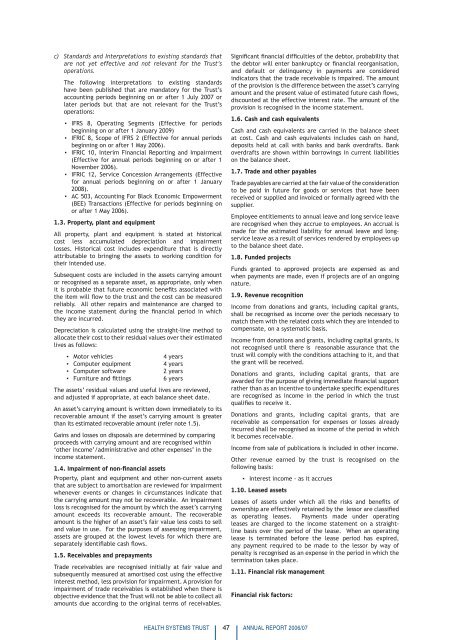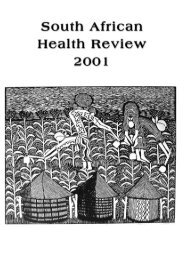anrep0607 - Health Systems Trust
anrep0607 - Health Systems Trust
anrep0607 - Health Systems Trust
Create successful ePaper yourself
Turn your PDF publications into a flip-book with our unique Google optimized e-Paper software.
c) Standards and Interpretations to existing standards that<br />
are not yet effective and not relevant for the <strong>Trust</strong>’s<br />
operations.<br />
The following interpretations to existing standards<br />
have been published that are mandatory for the <strong>Trust</strong>’s<br />
accounting periods beginning on or after 1 July 2007 or<br />
later periods but that are not relevant for the <strong>Trust</strong>’s<br />
operations:<br />
▪ IFRS 8, Operating Segments (Effective for periods<br />
beginning on or after 1 January 2009)<br />
▪ IFRIC 8, Scope of IFRS 2 (Effective for annual periods<br />
beginning on or after 1 May 2006).<br />
▪ IFRIC 10, Interim Financial Reporting and Impairment<br />
(Effective for annual periods beginning on or after 1<br />
November 2006).<br />
▪ IFRIC 12, Service Concession Arrangements (Effective<br />
for annual periods beginning on or after 1 January<br />
2008).<br />
▪ AC 503, Accounting For Black Economic Empowerment<br />
(BEE) Transactions (Effective for periods beginning on<br />
or after 1 May 2006).<br />
1.3. Property, plant and equipment<br />
All property, plant and equipment is stated at historical<br />
cost less accumulated depreciation and impairment<br />
losses. Historical cost includes expenditure that is directly<br />
attributable to bringing the assets to working condition for<br />
their intended use.<br />
Subsequent costs are included in the assets carrying amount<br />
or recognised as a separate asset, as appropriate, only when<br />
it is probable that future economic benefits associated with<br />
the item will flow to the trust and the cost can be measured<br />
reliably. All other repairs and maintenance are charged to<br />
the income statement during the financial period in which<br />
they are incurred.<br />
Depreciation is calculated using the straight-line method to<br />
allocate their cost to their residual values over their estimated<br />
lives as follows:<br />
▪<br />
▪<br />
▪<br />
▪<br />
Motor vehicles<br />
Computer equipment<br />
Computer software<br />
Furniture and fittings<br />
4 years<br />
4 years<br />
2 years<br />
6 years<br />
The assets’ residual values and useful lives are reviewed,<br />
and adjusted if appropriate, at each balance sheet date.<br />
An asset’s carrying amount is written down immediately to its<br />
recoverable amount if the asset’s carrying amount is greater<br />
than its estimated recoverable amount (refer note 1.5).<br />
Gains and losses on disposals are determined by comparing<br />
proceeds with carrying amount and are recognised within<br />
‘other income’/administrative and other expenses’ in the<br />
income statement.<br />
1.4. Impairment of non-financial assets<br />
Property, plant and equipment and other non-current assets<br />
that are subject to amortisation are reviewed for impairment<br />
whenever events or changes in circumstances indicate that<br />
the carrying amount may not be recoverable. An impairment<br />
loss is recognised for the amount by which the asset’s carrying<br />
amount exceeds its recoverable amount. The recoverable<br />
amount is the higher of an asset’s fair value less costs to sell<br />
and value in use. For the purposes of assessing impairment,<br />
assets are grouped at the lowest levels for which there are<br />
separately identifiable cash flows.<br />
1.5. Receivables and prepayments<br />
Trade receivables are recognised initially at fair value and<br />
subsequently measured at amortised cost using the effective<br />
interest method, less provision for impairment. A provision for<br />
impairment of trade receivables is established when there is<br />
objective evidence that the <strong>Trust</strong> will not be able to collect all<br />
amounts due according to the original terms of receivables.<br />
Significant financial difficulties of the debtor, probability that<br />
the debtor will enter bankruptcy or financial reorganisation,<br />
and default or delinquency in payments are considered<br />
indicators that the trade receivable is impaired. The amount<br />
of the provision is the difference between the asset’s carrying<br />
amount and the present value of estimated future cash flows,<br />
discounted at the effective interest rate. The amount of the<br />
provision is recognised in the income statement.<br />
1.6. Cash and cash equivalents<br />
Cash and cash equivalents are carried in the balance sheet<br />
at cost. Cash and cash equivalents includes cash on hand,<br />
deposits held at call with banks and bank overdrafts. Bank<br />
overdrafts are shown within borrowings in current liabilities<br />
on the balance sheet.<br />
1.7. Trade and other payables<br />
Trade payables are carried at the fair value of the consideration<br />
to be paid in future for goods or services that have been<br />
received or supplied and invoiced or formally agreed with the<br />
supplier.<br />
Employee entitlements to annual leave and long service leave<br />
are recognised when they accrue to employees. An accrual is<br />
made for the estimated liability for annual leave and longservice<br />
leave as a result of services rendered by employees up<br />
to the balance sheet date.<br />
1.8. Funded projects<br />
Funds granted to approved projects are expensed as and<br />
when payments are made, even if projects are of an ongoing<br />
nature.<br />
1.9. Revenue recognition<br />
Income from donations and grants, including capital grants,<br />
shall be recognised as income over the periods necessary to<br />
match them with the related costs which they are intended to<br />
compensate, on a systematic basis.<br />
Income from donations and grants, including capital grants, is<br />
not recognised until there is reasonable assurance that the<br />
trust will comply with the conditions attaching to it, and that<br />
the grant will be received.<br />
Donations and grants, including capital grants, that are<br />
awarded for the purpose of giving immediate financial support<br />
rather than as an incentive to undertake specific expenditures<br />
are recognised as income in the period in which the trust<br />
qualifies to receive it.<br />
Donations and grants, including capital grants, that are<br />
receivable as compensation for expenses or losses already<br />
incurred shall be recognised as income of the period in which<br />
it becomes receivable.<br />
Income from sale of publications is included in other income.<br />
Other revenue earned by the trust is recognised on the<br />
following basis:<br />
▪ Interest income - as it accrues<br />
1.10. Leased assets<br />
Leases of assets under which all the risks and benefits of<br />
ownership are effectively retained by the lessor are classified<br />
as operating leases. Payments made under operating<br />
leases are charged to the income statement on a straightline<br />
basis over the period of the lease. When an operating<br />
lease is terminated before the lease period has expired,<br />
any payment required to be made to the lessor by way of<br />
penalty is recognised as an expense in the period in which the<br />
termination takes place.<br />
1.11. Financial risk management<br />
Financial risk factors:<br />
HEALTH SYSTEMS TRUST 47 ANNUAL REPORT 2006/07

















